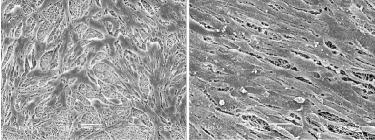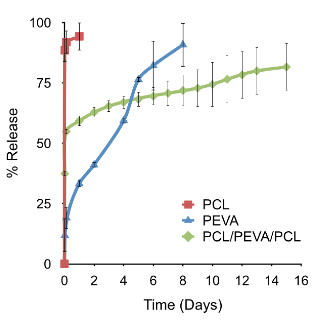 |
||||
|
|
||||
 |
||||
Research - Nanofibres |
||||
Nanofibres have dimensions similar to those of the extracellular matrix. As a result, they offer an excellent scaffold for the growth of a wide range of cell types, recreating the 3D environment which cells experience in vivo. Nanofibres are usually generated by a process called electrospinning (see movie), where a high voltage is passed through a polymer solution as it is slowly dispensed from a syringe. Depending on the setup, the nanofibres can be collected as random mats or aligned fibres, with the latter particularly suited to tissues where cellular alignment is paramount. Within our group, we are investigating various blends of natural and synthetic biomaterials for applications including musculoskeletal and neuronal tissue engineering. |
||||
Movie of the electrospinning process |
||||
 |
||||
Muscle cells on random (left) and aligned (right) nanofibres |
||||
|
||||||||||||
In addition to tissue engineering and regenerative medicine, nanofibres also have great potential for the controlled delivery of drugs, particularly in long-term local delivery systems such as antibiotic wound dressings. We have successfully demonstrated the encapsulation and controlled release of antibiotics from nanofibres fabricated from of a variety of biomaterials. These include polycaprolactone (PCL), poly(ethylene-co-vinyl acetate) (PEVA) and zein, a protein derived from sweetcorn. By designing these mats with layered structures, we can tailor the drug release profile in order to deliver therapeutic molecules over a number of weeks. These matrices are able to kill clinically-problematical species of bacteria, such as MRSA, even when the bacteria are growing in biofilms, which can be extremely resistant to conventional treatment regimes. An editorial giving an overview of our work in this area can be found here (p64-66). |
||||||||||||
